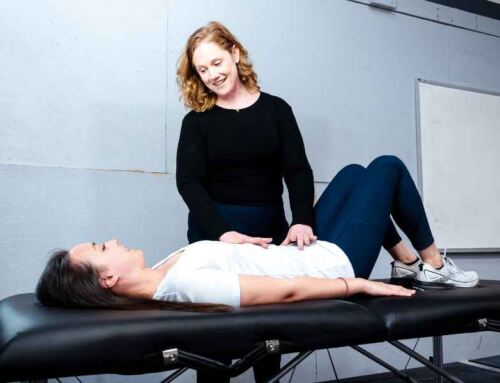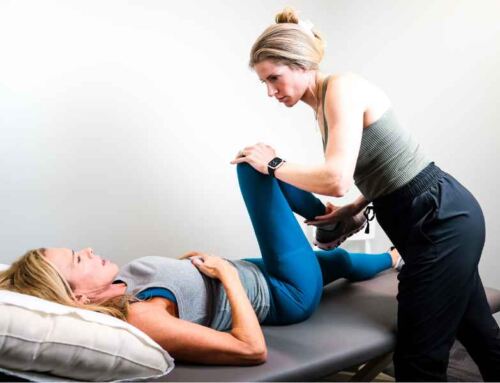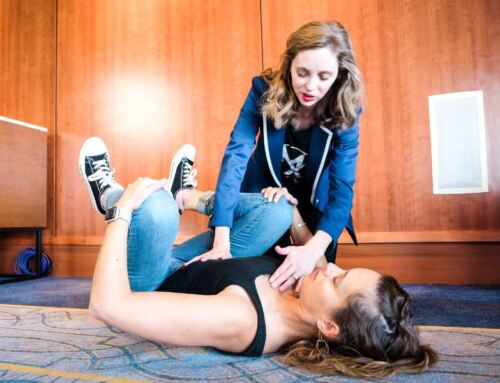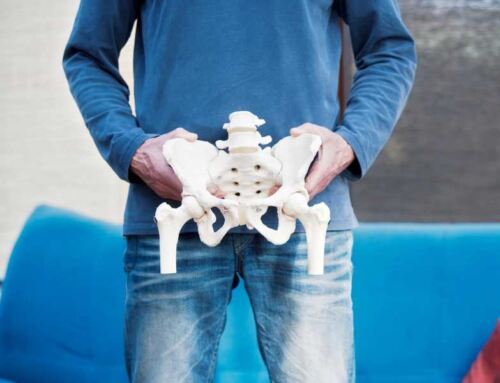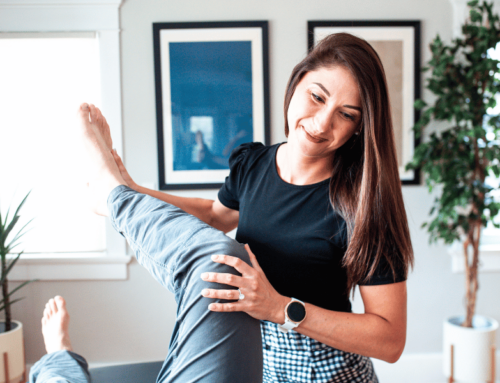When to see a PT for Postpartum Pelvic Girdle Pain
Pelvic girdle pain (PGP) has been widely discussed during pregnancy, but some people experience PGP in the postpartum period. PGP can make it challenging to care for a new baby, walk for exercise or stress relief, and even just get out of bed in the middle of the night.
The good news is that physical therapy is an important part of addressing and managing pain, even before a six week follow up with the OB/GYN.
What is Pelvic Girdle Pain Anyway?
The ring that makes up your pelvis from your hip bones to your sacrum in the back, is the pelvic girdle. So, the pain could be in the back at the sacroiliac joints (SIJ), or even in the front at the pubic symphysis.
However, low back and hip pain can mimic PGP, which is why a physical therapist will examine your spine and hips to identify the source of the problem. In fact, the world health organization recommends a screening for low back pain and an in-home visit within the first few weeks postpartum, which is why in-home physical therapy can be so beneficial.
While the exact cause of PGP is, unfortunately, not well understood, it’s thought to be related to altered timing of core muscles. The core is made up of the diaphragm, the pelvic floor, the abdominals, and the spinal extensors or back muscles.
In the short term, hands on treatment, such as soft tissue work, by a physical therapist may reduce pain.
However, the long term improvements in pain come from improved timing of contractions of the core muscles, gradual progression of core stability and general strengthening exercises.
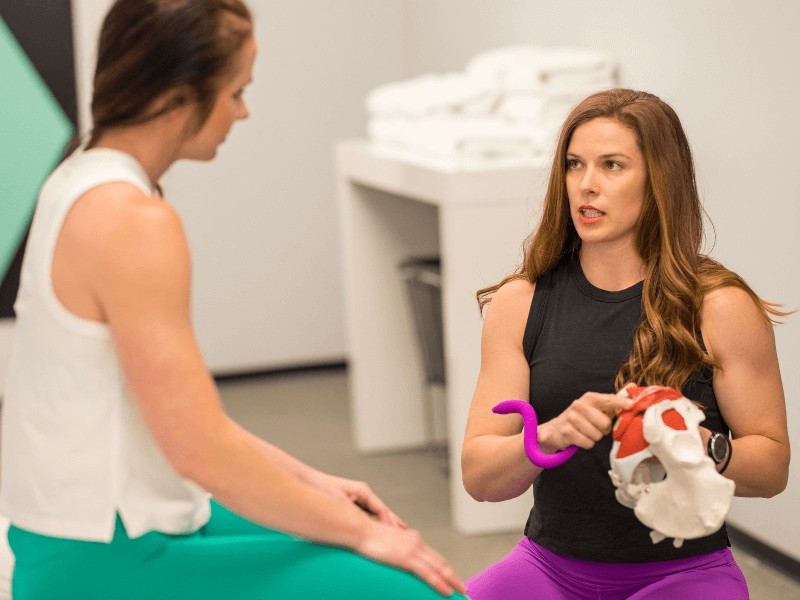
What exercises can I do to help with pain relief?
Treatment will depend on the individual, but there are a few exercises that may be helpful! It’s important to check pain levels after each exercise to ensure it is helpful for your unique symptoms. Here are 5 exercises to help you get started:
Supine Adductor Squeeze
This exercise can be helpful to directly reduce pain with activities such as walking. The exercise targets the adductors which work to help stabilize the pelvis as you move from one leg to another.
- Lying on your back with knees bent, place a pillow, ball, or yoga block between your knees
- Squeeze for 3 seconds, then relax
- Repeat 10 times
Cat-Cow
If you’re feeling stiff, cat-cow can help reduce stiffness and allow for greater range of motion in your core muscles for stability. It is best to stay within a pain free range as you do this.
- Set up on your hands and knees with hands below your shoulders and knees below your hips
- Slowly round your back to bring it up to the ceiling and tuck your tailbone under
- Then slowly arch your back to bring your belly button towards the floor
Supine March
The supine march is a great way to increase core stability while moving your legs, which carries over to walking, stairs, and moving from sitting to and from standing. This exercise should not cause pain, and if it does it may be too early to add into your routine.
- Lying on your back with knees bent, inhale to relax
- Exhale to engage your core
- Lift one foot on the floor
- Return foot to floor
- Inhale to relax
- Repeat on the other side
Adductor Glute Bridge
As the name suggests, this targets your glutes and adductors. These are two important stabilizing muscles for walking and moving from sitting to standing.
- Lie on your back with your knees bent, place a pillow or yoga block between knees, flatten your back on the floor
- Exhale as you lift your hips off the floor and squeeze your glutes, maintaining pressure on pillow/block between your knees.
- Return to the start position
Pallof Press
The pallof press is a more advanced exercise, and often better when pain has started to decrease. It targets a lot of muscles including the core, glutes, and adductors.
- Secure a band at belly button height to something stable like a stair banister, or closed in a door.
- Standing with the band secured to the side, exhale as you press the band forward without letting your body rotate
- Bring the band back to your belly button with arms bent
- Inhale to relax
- Repeat
Posture for Feeding
Posture for feeding may play a role in pain. Since infants feed often, it can be helpful to use pillows to support the baby to decrease the amount of weight you’re holding in your arms. Varying positions, such as lying on your side or reclining in a chair may also play a role in reducing pain.
The evidence for use of a pregnancy belt is mixed, but that doesn’t mean it won’t work for you. It can be helpful to have a skilled physical therapist examine you to better understand if a belt would be beneficial. However, if you’re unable to get in with someone quickly, it’s worth a try to allow you to move more freely before seeing a provider.
Should You Try a Pelvic Belt?
It depends.
A pelvic/SIJ belt is made of flexible and inflexible material to support the pelvis. It wraps around the hips, acting to assist the adductors and core to stabilize the pelvis as you transfer weight from one leg to the other.
The evidence for using a pelvic/SIJ belt for pain is a mixed bag. It works for some individuals, and not for others, which is why having a skilled physical therapist do an examination is important to better understand if it would be beneficial.
If you’re unable to get in with someone quickly, you could try a self test to better understand if it might be helpful for you.
Straight Leg Raise
- Lie on your back and lift one leg 6in off the floor. Bring it back down then try the other leg.
- Ask yourself: Was there pain or difficulty lifting one or both legs?
- Place your hands just below your hip bones and press in, or wrap a belt below your hip bones securely.
- Now try lifting a leg 6in off the table.
If it was easier, or had less pain, a pelvic belt may be helpful to reduce your pain.
If it made no difference, it’s less likely that pelvic/SIJ belt would be helpful.
Conclusion
Postpartum PGP can significantly impact daily life at a time where prioritizing your own self care can be challenging. However, early physical therapy, especially in-home care within the first few weeks, can provide an individualized approach to reduce your pain through manual techniques and stabilization exercises.
It’s important to remember that each person has a unique experience with PGP, which is why tailored treatment is essential. A skilled physical therapist can provide you exercises that fit into your busy schedule to make an early improvement on your symptoms and enable you to live your life.
References
- Simonds, Adrienne H. PT, PhD1; Abraham, Karen PT, PhD2; Spitznagle, Theresa PT, DPT, WCS3. Clinical Practice Guidelines for Pelvic Girdle Pain in the Postpartum Population. Journal of Women’s Health Physical Therapy 46(1):p E1-E38, January/March 2022. | DOI: 10.1097/JWH.0000000000000236
About the Author
Dr. Mattie Overton is a physical therapist in Durham, North Carolina. With over 15 years experience, she has a track record of helping a wide variety of patients live their best with added expertise in pelvic health, vestibular, and neurological treatments. If you’re looking for an ideal partner on your journey to wellness, look no further than Dr. Mattie Overton.



